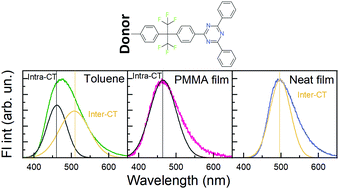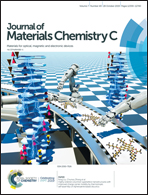Origin of dual emission in σ-bridged donor–acceptor TADF compounds†
Abstract
The desire to boost the reverse intersystem crossing rate and obtain thermally activated delayed fluorescence with sub-microsecond lifetime fosters the search for novel concepts of molecular geometry. Recently, TADF compounds made of acridine, tetramethylcarbazole and triphenylamine donor and triphenyltriazine acceptor units bound by hyperconjugated spacer units were introduced as having very rapid double TADF decay. Here we present an in-depth time-resolved fluorescence analysis of these intriguing donor–σ–acceptor TADF compounds in various surroundings. Extremely weak coupling of electron-donating and electron-accepting units was found for the σ-bridged TADF compounds, resulting in the coexistence of intramolecular and exciplex fluorescence, whose interplay allowed one to tune the emission properties. The initial fluorescence decay in toluene solutions, previously attributed to rapid TADF, was shown to be prompt intramolecular fluorescence with prolonged fluorescence lifetime, susceptible to molecular oxygen. Only the later delayed fluorescence at the microsecond time-scale, originating from the exciplex states, was attributed to TADF. On the contrary, dominant intramolecular TADF was observed in dilute PMMA films with weaker non-radiative decay. The smooth transition from intramolecular to exciplex TADF was observed by increasing the doping concentration of the polymer films. The DF/PF ratio was found to increase with increasing doping concentration due to the emergence of additional exciplex TADF until a 20 wt% doping load, where concentration quenching emerged at larger doping ratios. The presented findings showcase the unusual fluorescence properties of TADF compounds with weakly bound donor and acceptor units and are important for the future design of novel TADF compounds.



 Please wait while we load your content...
Please wait while we load your content...